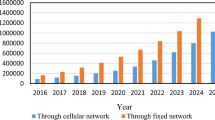Abstract
In this article, the authors investigate error rate (ER) analysis of multi-carrier code-division multiple access (MC-CDMA) for cognitive radio network (CRN) using the pre-coding technique. CRN is a type of frequency-sensitive device in wireless communication which can intellect the idle spectrum availability and assign the spectrum dynamically for mobile communication. The spectrum is subdivided and its sub-band frequency of CRN is used for implementing multi-carrier (MC) communication and generating the spread of code frequency generation. In this work, pre-processing technique using singular value decomposition is considered for alleviation of the effects of interferences arising from secondary users to ensure a reliable link between the base station and the active users. The null space of channel matrix of active interference primary users has been exploited for the formulation of pre-processing matrix. A time–frequency domain signature sequence has been constructed to suppress the adverse effects of adjacent cell interference (ACI) and secondary multi-user interferences (S-MUI). Further, iterative decoder has been implemented for the achievement of better coding gain when the primary users’ signals are contaminated by noise. Simulation ER results of CR MC-CDMA with pre-coding technique for Stanford University Interim and Long-term Evolution channels specification has been presented. It is discerned from ER results that coded CR MC-CDMA system established with pre-processing matrix offers robust performance through vindication of ACI and S-MUI effects while retaining a low complexity of primary mobile station for downlink transmission. Additionally, CRN-based MC-CDMA system has been analysed and found to provide an efficient and flexible solution to fulfil the demands of spectrum utilization.






Similar content being viewed by others
References
Sridharan B, Ravi A, Haribhaskaran AS, Nagaradjane P (2014) Cooperative downlink MC-CDMA System aided by transmitter preprocessing: performance results. In: 21st International Conference on Telecommunications, pp 145–149
Karthipan R, Vishvaksenan KS, Kalidoss R, Krishan A (2016) Performance of turbo coded triply-polarized MIMO-CDMA system for downlink communication. J Comput Electr Eng 56:182–192
Kondo S, Milstein LB (1996) Performance of multicarrier DS CDMA systems. IEEE Trans Commun 44(2):238–246
Zhang R, Hanzo L (2007) Iteratively detected multi-carrier interleave division multiple access. In: International Conference MICROC0LL’07, BUDAPEST, Hungary
Nagaradjane P, Ravichandran S, Srinivasan N, Ravichandran S, Damodaran SP (2013) Cooperative communication-aided multi-carrier code division multiple access downlink transmission with transmitter preprocessing: performance results. IET Commun 2013(7):1915–1924
Partibane B, Nagarajan V, Vishvaksenan KS, Kalidoss R (2015) Performance of multi-user transmitter pre-processing assisted multi-cell IDMA system for downlink transmission. Fluct Noise Lett. https://doi.org/10.1142/s02194775155003032015
Yang LL (2008) A zero-forcing multiuser transmitter preprocessing scheme for downlink communications. IEEE Trans Commun 56:862–865
Rajmohan R, Vishvaksenan KS, Mira M, Subramanian S (2016) Performance of a turbo-coded downlink IDMA system using transmitter pre-processing. Comput Electr Eng 53:385–393
Kim S, Sung W (2014) Operational algorithm for wireless communication systems using cognitive radio. In: 2014 IEEE International Conference on Communication, Networks and Satellite (COMNETSAT)
Xiao J, Ye F, Tian T, Hu RQ (2011) CR enabled TD-LTE within TV white space: system level performance analysis. In: IEEE Global Telecommunications Conference, pp 1–6
Shahrokhand H, Mohamed-Pour K (2009) A new structure for NC-MC-CDMA in cognitive radio networks. In: 9th International Symposium on Communications and Information Technology, pp 653–657
Attar A, Nakhai MR, Aghvami AH (2008) Cognitive radio transmission based on direct sequence MC-CDMA. IEEE Trans Wirel Commun 7(4):1157–1162
Jasbi F, So DKC (2016) Hybrid overlay/underlay cognitive radio network with MC-CDMA. IEEE Trans Veh Technol 65(4):2038–2047
Jasbi F, So DKC, Alsusa E (2013) Hybrid overlay/underlay MC-CDMA for cognitive radio networks with mmse channel equalization. In: IEEE Global Communications Conference (GLOBECOM), pp 1056–1061
Tadrous J, Sultan A, Nafie M (2011) Admission and power control for spectrum sharing cognitive radio networks. IEEE Trans Wirel Commun 10(6):1945–1955
Kabir MA, Kaiser MS (2015) Outage capacity analysis of MC-CDMA based on cognitive radio network. In: 2nd International Conference on Electrical Engineering and Information and Communication Technology (ICEEICT)
Rajabzadeh M, Khoshbin H (2010) Receiver design for downlink MIMO MC-CDMA in cognitive radio systems. In: 21st Annual IEEE International Symposium on Personal, Indoor and Mobile Radio Communications, pp 786–790
Zhou R, Li X, Chakravarthy V, Wu Z (2011) Software defined radio implementation of SMSE based overlay cognitive radio in high mobility environment. In: IEEE Global Telecommunications Conference—GLOBECOM 2011, pp 1–5
Forney G (1966) Concatenated codes. MIT Press, Cambridge
Berrou C, Glavieux A, Thitimajshima P (1993) Near Shannon limit error correcting coding and decoding: turbo codes. In: Proceedings of IEEE ICC, pp 1064–1070
Le Goff S, Glavieux A, Berrou C (1994) Turbo-codes and high spectral efficiency modulation. In: Proceedings of the IEEE International Conference on Commununication, New Orleans, LA, pp 645–649
Benedetto S, Divsalar D, Montorsi G, Pollara F (1995) Bandwidth efficient parallel concatenated coding schemes. Electron Lett 31(24):2067–2069
Robertson P, Worz T (1995) Coded modulation scheme employing turbo codes. Electron Lett 31(18):1546–1547
Benedetto S, Divsalar D, Montorsi G, Pollara F (1997) Serial concatenated trellis coded modulation with iterative decoding. In: IEEE International Symposium on Information Theory, Ulm, Germany
Maucher J, Furrer J (2007) Heise, IEEE Std. 2007. IEEE standard for WIMAX 802.16, Hannover
3GPPP (TR 30.803) (2007) Evolved universal terrestrial radio access (E-UTRA); user equipment (UE) radio transmission and reception (Release 8). Technical specification, Sophia Antipolis, France
Mithra K, Vishvaksenan KS (2017) Performance of coded STBC-IDMA system using polarization diversity for downlink transmission. Clust Comput 20(2):1615–1623
Author information
Authors and Affiliations
Corresponding author
Rights and permissions
About this article
Cite this article
Kumar, R.D., Vishvaksenan, K.S. Interference cancellation in cognitive radio-based MC-CDMA system using pre-coding technique. J Supercomput 76, 1–15 (2020). https://doi.org/10.1007/s11227-018-2503-6
Published:
Issue Date:
DOI: https://doi.org/10.1007/s11227-018-2503-6




